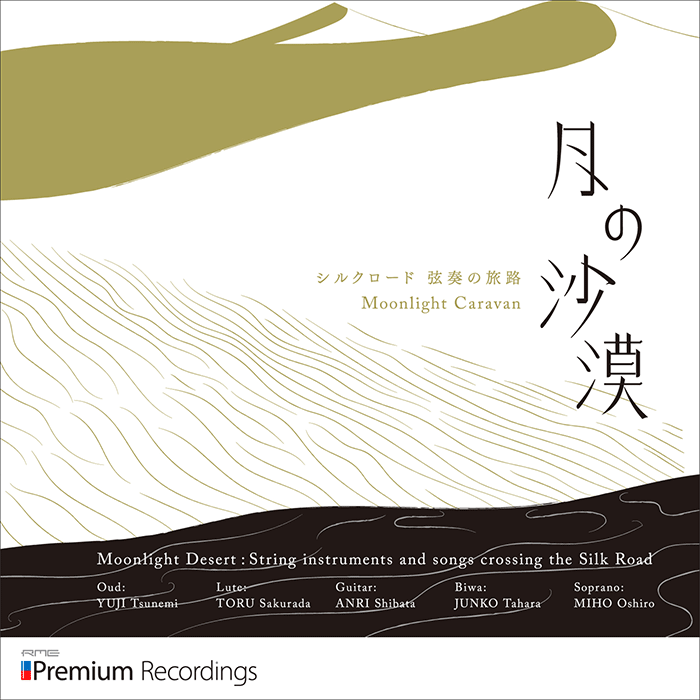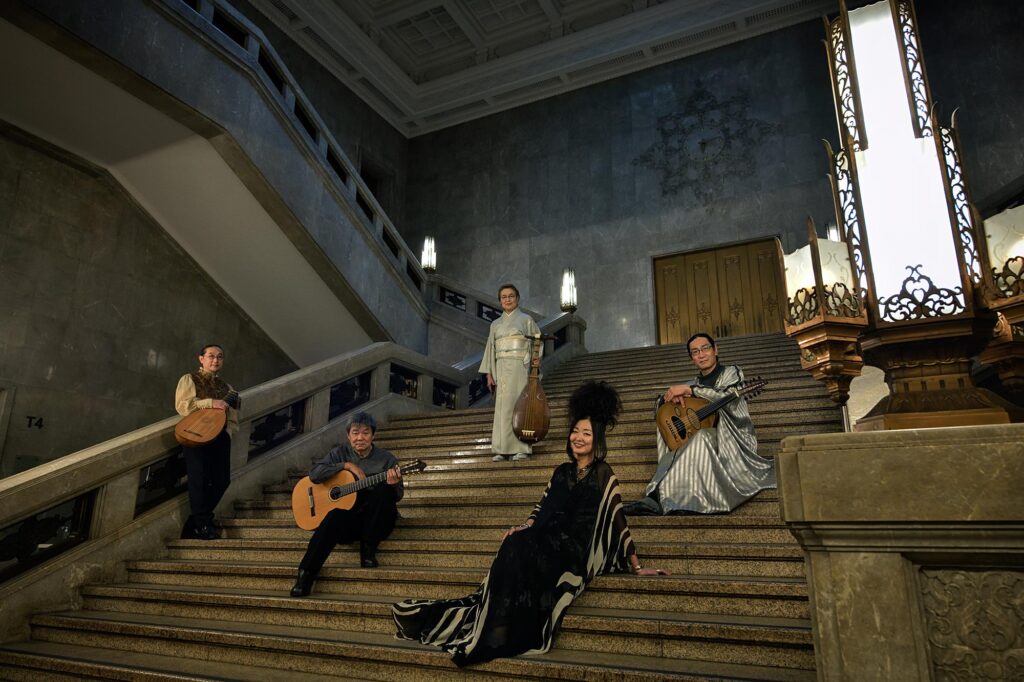Moonlight Desert: String Instruments and Songs Crossing the Silk Road
Moonlight Caravan
Plucked string instruments bound by the threads of fate. The charm of song has always accompanied these instruments. Their presence overwhelming, musical warriors line up, having followed their own paths despite being tossed about by the rough seas of life.
Of all the instruments invented by humankind, string instruments that produce sound when their strings are plucked by fingers or a plectrum are said to have a history second in length only to percussion instruments. Their roots can be traced back to an instrument that originated in Sasanian Persia, the oud. Known as the “queen of instruments,” the oud is loved throughout the Arab world even today. It was disseminated down desert roads to the East and West via the Silk Road, transforming according to local climates and preferences to become the lute and the guitar in the West, and the biwa in the East.
Moonlight Caravan brings Japan’s leading performers of these instruments together via a shared DNA. This work was performed at Chichibu Muse Park Music Hall, where stone lends a rich resonance to their notes. We hope you enjoy it.

Moonlight Desert: String Instruments and Songs Crossing the Silk Road
Moonlight Caravan
MQA-CD 176.4kHz/24bit


The CDs are mastered in HPL and MQA so the music is in high-resolution 3D which can be played on a normal CD player. If your player supports MQA, it automatically decodes the CD so you can enjoy the music at PCM 176.4kHz/24bit. If your player does not support MQA, you can still enjoy the music at 44.1kHz/16bit in the normal CD format.
The CDs have been fine-tuned with HPL processing so you can enjoy realistic sound, whether via binaural listening over headphones or over normal stereo speakers.
(When using speakers, we recommend a listening environment with as little reflected sound as possible.)


MQA-CD is a breakthrough audio technology that allows music fans to stream original master recordings into their home, car, or on their mobile device. This award-winning British technology is based on the latest neuroscience research and it captures every element of a recording’s resolution and energy.
Capturing this level of detail recreates a natural sound of the audio source, enables enabling the listener to perceive the instruments and performers vividly through a rich and immersive audio experience and build a sonic 3D picture that captures the depth of the sound.
MQA’s proprietary “origami” enfolding technology makes sure the data containing the musical information is packaged efficiently and that it retains all the information from the studio recording.
Album Overview
Recording date and location:
October 19-20, 2017,
at Chichibu Muse Park Music Hall
Recording, mixing, editing, mastering:
Hideo Irimajiri (WOWOW Inc.)
Recording format:
PCM 192kHz / 24bit
Track List
| 1 | Bashraf Samaai Asbaain | (Composer unknown) |
| 2 | Muwashahah “Lammabada yatathanna” | (Arab court music) |
| 3 | Kull Da Kan leh | (composer: Muhammad Abudl Wahab) |
| 4 | Tsuki no sabaku (Desert Moonlight) | (Poem: Masao Kato; Composer: Suguru Sasaki) |
| 5 | Italiana & Siciliana | (Composer unknown) |
| 6 | Amarilli | (Composer: Giulio Caccini) |
| 7 | Down by The Salley Gardens | (Irish folk song) |
| 8 | “Ave Maria” by Caccini | (Composer: Vladimir Fiodorovich Vavilov) |
| 9 | Sumu Gaga | (Composer: Jose Angel Navarro) |
| 10 | Willow | (Composer: Lu chao-Hsuan) |
| 11 | “Gion Shōja” from The Tale of the Heike | (Composer: Yamazaki Kyokusui / Junko Tahara) |
| 12 | “Nasu no Yoichi” from The Tale of the Heike | (Composer: Tachibana Kyokusō I) |
| 13 | Hana no Uta | (Poem: Makoto Sato; Composer: Junko Tahara) |
Introduction to the Plucked String Instruments Featured in This Work
Oud
The oud, which appears in the Arabian Nights, is an instrument with a long history spanning two thousand years. Its origins are said to be found in the barbat, a Sasanian Persian instrument. The name “oud” is said to derive from the Arabic word al’ud, meaning “thin piece of wood,” and is believed to be the etymological root of the English word “wood.” Crafted from various types of wood, the pear-shaped body is made of thin strips of wood joined together, making it nice and light. It has eleven strings and no frets. Traditionally, the oud was played using a risha or bird feather quill (usually an eagle’s), but in recent times, it has come to be commonly played with a nylon plectrum. Its microtonal characteristics are particularly attractive and make it an essential instrument in Arab music that continues to be loved to this day. Oud playing techniques have been passed down orally since ancient times.
Lute
The instrument used in this work is an eight-course Renaissance lute made by Canadian Richard Berg. Only the first string, which produces the highest note, is a single string; the others are double strings, for a total of fifteen gut strings. The frets, also made of gut and doubled, can be adjusted for tuning. The soundboard is made of German spruce, and the back is made of thirteen yew ribs. Despite its size, it is surprisingly light, like the oud. The basic technique is to play with the thumb, index finger, and middle finger of the right hand without using the fingernails. Eighty percent of instrumental music published before 1600 was for the lute, and many tablature scores—instrument-specific musical scores written using letters and numbers—still remain today.
Guitar
Derived from the lute, the guitar is called a “small orchestra” because of its rich color and versatility. Most guitars have six strings and nineteen frets. The guitar used in this work was made by Greg Smallman (Australia). Its soundboard structure is unique, employing lattice bracing and carbon fiber, with the soundboard being made of cedar and the backboard of jacaranda. It is heavier than a traditional guitar.
Biwa
The biwa is an instrument believed to have been brought to Japan from the Arab regions via the Silk Road. It has the longest history of any instrument imported to Japan, having been introduced during the reign of Emperor Shomu (701-756). The biwa the emperor most favored is still housed in the Shosoin Repository at Todaiji Temple in Nara. Through the ages, the shape of the instrument has gradually changed, from the gagaku biwa to the moso biwa, the Heike biwa, the Satsuma biwa, and the Chikuzen biwa, and the music played on these instruments has changed over the years to the present day. The instrument used in this work is a five-stringed, five-fret biwa made around 1980 that combines the advantages of the Satsuma biwa and the Chikuzen biwa. Both the front and back soundboards are made of mulberry wood, and the strings are silk.
The recording of this unparalleled ensemble—consisting of oud, lute, guitar, biwa, and soprano—was undertaken by immersive audio pioneer Hideo Irimajiri. To accurately capture the resonance of plucked string instruments, which are already very soft, the microphone positions were carefully adjusted to express “height,” and the recording was done in 13-channel immersive sound (AURO 13.1 format). Based on this, we created an HPL format that allows listeners to easily experience 3D sound even with headphones, as well as 5-channel surround sound. Of course, there is also a standard 2-channel stereo mix available. All versions are distributed in 192kHz / 24-bit format. OTTAVA Records will release the album as an MQA-CD (176.4kHz – 24-bit).

Moonlight Caravan
From left:
Toru Sakurada (lute)
Anri Shibata (guitar)
Junko Tahara (biwa)
Miho Oshiro (soprano)
Yuji Tsunemi (oud)
Yuji Tsunemi
Yuji Tsunemi is regarded as a pioneer and a leading oud performer not only in Japan but also throughout East Asia. He studied under the late Sudanese oud player Hamza El Din, and in 1989, he studied under the late Ali Sriti, a leading Tunisian oud player in the Arab world. After returning to Japan, he has pursued an active performance career. He continues to convey the charm of the oud while also contributing to the development of Japanese oud players and influencing various musical genres. In addition to live performances and concerts throughout Japan, he also frequently performs at embassies of various countries in Tokyo, and served as supervisor for Arab music for NHK’s The New Silk Road. He has written and recorded many songs, and his unique presence has been widely featured on television and radio. http://www.oud.jp/
Toru Sakurada
After graduating from the Japan Guitar School, he studied lute under Toyohiko Satoh at the Royal Conservatoire the Hague in the Netherlands. He plays a wide range of plucked instruments in the lute family, using each appropriately according to the era and the music being played. His performance style—using gut strings to draw out the historical expressiveness of pieces—is rare even overseas. As an accompanist, his flexibility in adapting to the situation at hand has earned him the trust of his many collaborators. His solo CDs include Yasuragi no Gut (Varietie of Lute Collections: Toru Sakurada – Favorite Lute Music, Anthology on seven all-gut-string lutes), Kōtei no Bieuera / Shimin no Lute (Narvaez s Newsidler: Toru Sakurada [Vihuela, Lute]) (recommended by Record Geijutsu magazine, quasi-special selection), Pachelbel: Koibito no Tameiki (Pachelbel: Sighs of a Lover) (same selection), and Teorubo no Ongaku (Theorbo) (same selection). His trio CD Music from the Netherlands, released in 2017 with Toyohiko Satoh and Miki Satoh, was chosen as a special selection by Record Geijutsu magazine. He serves as the Secretary General of the Lute and Early Guitar Society Japan. http://www.lutelute.com/
Anri Shibata (guitar)
(Guitar)
Graduated at the top of his class from the Madrid Royal Conservatory. While in Spain, he studied under Jorge Ariza, Narcisco Yepes, Sainz de la Maza, and José Luis González. He won first place at the 1978 Francisco Tárrega International Guitar Competition, and at the 1982 José Luis González International Guitar Competition. In November 1998, he was invited by the Brazilian government to serve as a judge at the 6th Villa-Lobos International Guitar Competition, where he also held a concert. He has released several solo albums—El Rastro, Para Su Novia, El Mestizo, and The Prince’s Toys, which have all become exceptionally long-selling classical CDs. A highly talented accompanist and arranger, he has arranged and accompanied a variety of ensembles, including strings, winds, and vocal works. He is renowned for his diverse repertoire, ranging from classical to contemporary music. His exceptional musicality and natural sense of rhythm captivate listeners, and he has a large fan base across generations.
Junko Tahara (biwa)
(Biwa)
A biwa player who enjoys performing concerts in small halls where she can engage in conversation with the audience. She performs not only traditional narrative works such as The Tale of the Heike, but also many contemporary and original narrative pieces, continually exploring biwa music to suit modern sensibilities. She studied the Chikuzen biwa under the late Mikiko Yamada and Yamazaki Kyokusui (a Living National Treasure). In 1982, she won first place in the Biwa Competition. She is a recipient of the Education Minister’s Encouragement Prize and the Japan Broadcasting Corporation Chairman’s Award. In addition to holding recitals and concerts around the world, she actively undertakes new creative projects, including premiering original works. As a member of Pro Musica Nipponia, she has performed not only in Japan but also around the world. She received the Ongaku no Tomo Sha Prize and the Remy Martin Music Award in 1979, the Matsuo Performing Arts Award in 1988, and the Mobile Music Award in 1990. In 2005, she released an 8-part CD series of The Tale of the Heike: Miyao’s Book. http://naks.biz/biwa-jun/
Miho Oshiro (soprano)
(Soprano)
Graduated from the Musashino Academia Musicae’s Vocal Course. After performing with a professional choir, she went freelance. In addition to numerous concert appearances at halls and music salons around the country, she has also participated in many performances for television, radio, CDs, film scores, and educational materials. She has performed as a soloist for works such as Beethoven’s Symphony No. 9 and Messiah, and performs songs from nine countries in their original languages. She has given eleven solo and guitar duo recitals in Tokyo. As part of the duo “UTAUD” with oud player Yuji Tsunemi, she pursues a crossover classical style that combines Arabic music and traditional Japanese folk songs, with her wide-ranging performances centering around ensembles. A lover of plucked string instruments, she has planned, hosted, and performed in the Moonlight Caravan Concert series since 2012. Her CDs include Yamato Shi Utsukushii (Beautiful Yamato), España, and Tsuki ni Yosu (To the Moon). With her soothing, silky voice and her striking stage presence owing to her 172cm height, she continues to captivate fans. http://www.oshiromiho.com/

Hideo Irimajiri
(WOWOW Inc.)
Born in 1956. Graduated from the Kyushu Institute of Design in 1979 with a degree in acoustic design, and again in 1981 with a master’s degree from the same institute. He was awarded a Ph.D. in Art and Engineering in 2013 for his research on reverberation. In 1981, he joined Mainichi Broadcasting System, Inc. He worked in the video technology, audio technology, hall technology and postproduction, and mastering departments before being seconded to WOWOW Inc. in 2017. In 1987, he was involved in the broadcasting industry’s first surround sound broadcast of high school baseball. Since 2005, he has researched loudness issues in broadcasting and has also worked towards standardization as a member of ARIB and The Japan Commercial Broadcasters Association. He began recording as a student, exploring 4-channel recording and spatial acoustics in particular. He is currently developing 3D audio recording technology and is actively involved in its production and promotion. He also pursues personal recording projects under the name Jiro Iruma and has composed pieces such as the opening theme for the Hanazono National High School Rugby Tournament and the music for the PC game Record of Lodoss War.

